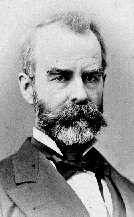Eli T. Tappan
1824 -1888

Eli Todd Tappan, the only child of Judge Benjamin Tappan and his second wife, Elizabeth Frazer, was born in Steubenville, Ohio, on April 30, 1824. Benjamin Tappan had been the first settler of Ravenna, Ohio, in 1799 and had served as a member of the first Ohio Senate from 1803 to 1805. He was later appointed as a federal judge and served in the United States Senate from 1839 to 1845. President Andrew Jackson nominated him to the U. S. Supreme Court, but the Senate refused to confirm him because of his strong anti-slavery stance.
Eli Tappan was educated in the public schools of Steubenville and by private tutors. He enrolled at St. Mary's College in Baltimore while his father was serving in Washington, but he left the college in 1842 before completing the course of study. He received an (honorary) A. M. degree from St. Mary's in 1860.
He immediately began studying law under his father and his father's partner, Edwin M. Stanton, who would become famous as President Lincoln's Secretary of War. Tappan was admitted to the Ohio bar in 1846, and that same year he founded the weekly Ohio Press newspaper in Columbus, which he published for two years. In 1848 he returned to Steubenville and began practicing law. He served as Mayor in 1852. On February 4, 1851, he married Lydia L. McDowell, and the couple had two children.
On February 2, 1854, Tappan delivered a lecture on "Arithmetic" to the Union Institute of Teachers and Friends of Education for Jefferson and Harrison counties. This started him on the path of education. When the Union Institute was succeeded by the Normal Class of Teachers of the City Schools of Steubenville in 1857, Tappan was named as its teacher of arithmetic. That fall he began teaching in the Steubenville public schools, and the following year he became the superintendent.
In 1857 Tappan posed the following problem in the Mathematical Department of the Ohio Journal of Education. "On each side of any triangle construct an equilateral triangle and connect the centers of these equilateral triangles. Prove that the connecting lines form an equilateral triangle." This result is often called "Napoleon's Theorem," but most historians of mathematics doubt that Napoleon ever proved it. Tappan solved two other problems posed in the journal. One is a max-min problem, solved by differential calculus, and the other is an arithmetic problem equivalent to "casting out elevens."
In the fall of 1859 Tappan was elected professor of mathematics at Ohio University, but he left Athens after one year for a position at the Mt. Auburn Young Ladies' Institute near Cincinnati, where he remained until 1865. During this period, he wrote Elements of Plane and Solid Geometry for Ray's series of mathematical textbooks. In September 1865 he was recalled to the professorship of mathematics at Ohio University, where he wrote a Treatise on Geometry and Trigonometry for Ray's series. His style as a writer has been characterized as "plain and direct." It was said that he could "pack the most meaning into the fewest words."
In 1868 Tappan was elected president of Kenyon College in Gambier, Ohio. As president, he completed building the chapel and completely revised the curriculum. His installation brought high hopes for Kenyon, but the anticipated prosperity did not materialize, and student attendance fell from 70 to 50 during his term. He was evidently unpopular with the students. One member of the class of 1876 described him as "a man with a narrow forehead and a narrower mind [without] a spark of humor in his make up." He tendered his resignation in 1874, but was persuaded to remain on the faculty as professor of mathematics and political economy.
In December 1856, Tappan had attended his first meeting of the Ohio Teachers Association. Ten years later he was inaugurated as president of that organization. He went on to become an officer of the National Education Association, serving as its treasurer (1880-81) and president (1883). The honorary degree of LL.D. was conferred upon him by Williams College in 1873 and by Washington and Jefferson College in 1874.
Tappan was a champion of the common schools. In 1874 he spoke to the Association of Colleges of Ohio about the relation of colleges to high schools. The following summer he addressed the Ohio Teachers' Association on "Qualifications for Admission to College." Topping his list were: upright character, a desire for a higher education, and a faculty for hard mental work. His History of School Legislation in Ohio was published by the State of Ohio for its school exhibit at the 1876 Centennial Exposition in Philadelphia.
In 1886 Tappan was elected as an honorary member of the Association for the Improvement of Geometrical Teaching in England. That same year he was elected State Commissioner of Common Schools, and he assumed that office in 1887. Eli T. Tappan died on October 23, 1888 of "brain paralysis," brought on by heart disease.
REFERENCES
- Biographical Cyclopædia and Portrait Gallery with an Historical Sketch of the State of Ohio (vol. 5), Cincinnati, Western Biographical Publishing Company, 1883, pp. 1251-53.
- Dye, Charles M. "Eli Todd Tappan," Biographical Dictionary of American Educators (vol. 3), Westport, CT, Greenwood Press, 1978, pp. 1269-70.
- McGuffey, Edward M. (Class of 1876), "The Spirit of 76," Letter to The Kenyon Collegian, Spring 1927, p. 2.
- Minnich, Harvey C. "Eli Todd Tappan," Dictionary of American Biography (vol 18, part 2), New York, Charles Scribner's Sons, 1937, p. 301.
- Smythe, George F. Kenyon College: Its First Century, New Haven, Yale University Press, 1924, pp. 200-211.
- Tappan, Eli T. "Qualifications for Admission to College," Ohio Educational Monthly, 24 (1875), 286-93.
Article by David E. Kullman
Miami University
